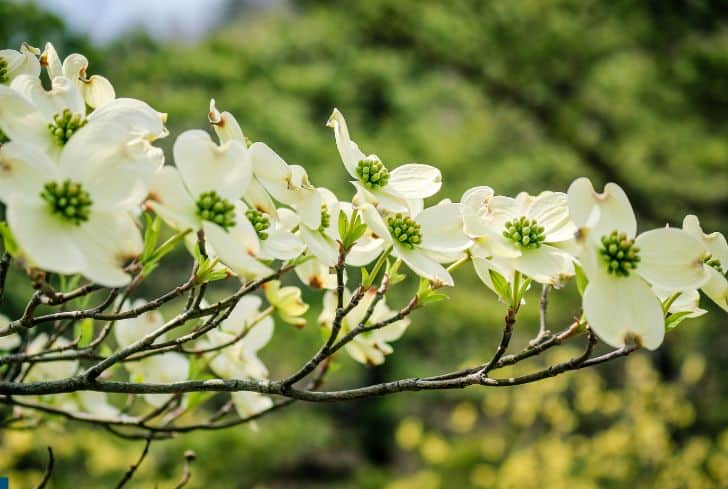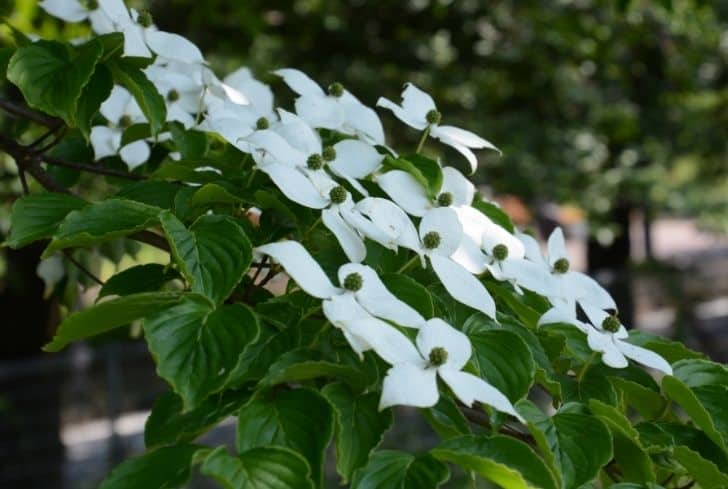Dogwood trees in full bloom are the epitome of springtime. Their soft pink and white flowers are tiny and delicate and offer a sweet aroma carried on the spring breeze. If you hope to add some of these fan-favorite trees to your garden space, you may wonder when dogwood trees bloom.
When Does Dogwood Bloom?
Dogwood trees mark the end of long cold winters. They are known to put on a beautiful floral display in early spring, sometimes even before spring bulbs have emerged. Most dogwood tree varieties bloom from April to mid-May, offering fragrant flowers for 2-4 weeks.
Since dogwood trees are some of the first shrubs and trees to bloom each spring, many people like to add them to their home gardens and landscapes for that pop of color after bleak and cold winters.
How Long Do Dogwood Trees Bloom?
Dogwood trees have a relatively short bloom period compared to other flowering shrubs and trees of 2-4 weeks. While the blooms’ actual time will last depends on many factors, these ornamental beauties provide a vivid welcome to spring, even if short-lived.
Pink dogwood is a common choice for homeowners looking to add some color and interest to their landscape or garden. These trees offer delicate pastel pink flowers during the springtime. Even though the bloom time is similar to other dogwood varieties, just 2-4 weeks, the tree also provides beauty in different seasons.
Their leaves fade to purple in the fall, producing red berries that attract butterflies. Even in the winter, the branches are thin and create an interesting design, making dogwood trees a perfect focal point all year.
Why is My Dogwood Not Blooming?
Since dogwood trees are often planted solely for their beautiful springtime blooms, it can be incredibly frustrating when your dogwood doesn’t flower! There are many reasons why your dogwood tree is not flowering, including too much nitrogen, too much or not enough sunlight, under watering, too much pruning, or cold snaps.
Look at the soil if you notice that your dogwood tree isn’t flowering. Too much nitrogen in the soil can prevent the tree from being able to blossom. Many dogwood trees are planted and grown in lawns that are treated with fertilizer. While these nitrogen-rich fertilizers are great for the lawn and the leaves of the plant, limit the fertilizer used if you notice your dogwood isn’t flowering.
Dogwood trees are naturally found on the edges of forests, receiving scattered light and time in the shade. The leaves can become sunburnt and die off if the tree is grown in full sun. This is especially a problem in areas that are humid and extremely hot.
The other side of the problem is a dogwood tree grown in too much shade. Without adequate sunlight, the tree will not be able to make enough energy to grow flowers.
In addition to sunlight, the amount of water a tree receives is vital to its flower production. You will want to water your dogwood tree deeply once a week in the springtime and as needed in the hot summer months. The leaves could wither and die off if the tree is not watered properly. Without enough leaves, the tree will spend all its energy regrowing new leaves instead of growing flowers.
Along the same line, a dogwood tree pruned back too far back will also be less likely to flower. This is due to the amount of energy required to regrow the leaves and branches previously removed. To avoid this problem, do not remove more than 10% of the tree at any time.
Dogwoods do not usually need much pruning, but if you hope to keep the size controlled, prune the tree back in the fall after the leaves have died off.
While you can somewhat control where you plant the tree and how much sunlight or water it gets, you cannot control the weather. Cold snaps are typical in early spring; a sudden frost can kill off any fresh buds the plant has created. Frostbitten dogwood trees will likely make a comeback but often will not flower.
Do Dogwood Trees Need Full Sun?
Like all flowering plants, the sun is necessary to create the ideal environment that will inspire beautiful and full blooms. However, dogwood trees are naturally found on the edges of forests and prefer half days of sun. Therefore, without adequate sunlight, your dogwood tree will not bloom as much as it would if placed in an area that receives at least 3 hours of daylight.
Dogwood trees are some of the first trees to bloom in the springtime. During the winter months, the tree survives by going dormant. During this time, all the leaves die and fall away, and the plant does not make new ones. Instead, they will store their energy and use it sparingly to survive the winter and grow new buds in the springtime.
Once new leaves have emerged from your tree, the leaves will take over and begin making new energy from the sun in a process called photosynthesis. During this process, the leaves’ chlorophyll turns the sun’s UV rays into glucose that the plant can use to grow and eventually produce flowers.
A plant grown in adequate sunlight will be able to create more energy at a quicker rate, thus blooming earlier and producing more blooms.
While you can grow a dogwood tree in a spot that does not receive 3 hours of sun, the tree may flower very little or not at all.

Do Dogwood Trees Smell?
Dogwood trees offer more than just beautiful bold blooms; they also welcome springtime with a pleasant scent that has an aroma similar to honeysuckle. Unfortunately, while the smell is appealing to most people, you do not get to experience it for long. Dogwood trees only bloom for about two weeks each spring.
If you notice your dogwood tree is giving off an unpleasant smell, there could be a few problems. First, dogwood trees are temperamental and may produce flowers that smell less than ideal if they grow in a stressful situation.
Inadequate water is a primary reason for foul-smelling flowers, but even then, it is not common for dogwood to smell unpleasant or “fishy.”
If you notice a fishy smell, you are more likely not dealing with a dogwood tree but, instead, have a Bradford pear tree. These trees also produce small flowers similar to a dogwood tree. However, these trees are known for their foul smell.
The Bradford pear tree owes its smell to organic compounds found in its flowers that are molecularly similar to ammonia, giving the plant a “fishy” smell.
Be sure to pay close attention to the difference in trees when choosing one from a nursery to prevent a mix-up. Nothing will spoil your springtime like foul-smelling flowers when you are expecting honeysuckle.
Do Deer Like Dogwood Trees?
Nothing is more disheartening than seeing your beautiful plants eaten and destroyed by deer. Deer may occasionally nibble on dogwood trees or shrubs, but the plant is resilient and will bounce back. Unfortunately, while they are a deer-resistant plant, they are not deer-proof.
Deer enjoy plants with soft and smooth leaves and foliage, similar to hostas. However, hungry deer will eat anything they can find if experiencing famine or habitat decline.
Luckily, dogwood trees are very resilient. So even if a deer does enjoy a few branches or flowers from the tree, your tree will regrow itself in no time.
Suppose you are concerned about protecting your dogwood trees or other garden plants. In that case, you can plant deer repellent companion plants, sprinkle spent coffee grounds around your yard, or purchase chemical deer repellent at your local farm or outdoor store.
Common plants that deter deer include marigolds, chives, bleeding hearts, sage, bee balm, daffodils, and lamb’s ear.
Summary
Dogwood trees begin to bloom around April and can bloom until about mid-May. Their soft and delicate flowers are commonly thought of when one thinks of springtime blooms, making them a fan favorite for landscapes and gardens.
These trees have a short bloom time, usually only lasting 2-4 weeks before the blooms are spent. After their blooms, dogwood trees are also loved for their leaves which turn purple in the fall. They also have unique branches that offer visual interest even in the winter.
Sometimes, deer may munch on dogwood trees. However, these plants are resilient and will bounce back quickly, regrowing any foliage that was removed.
Dogwood trees are the perfect addition to any garden or landscape. If you hope to create a thriving environment for your dogwood trees, grow them in half a day of sun, water them thoroughly, and avoid overfertilizing your lawn.






